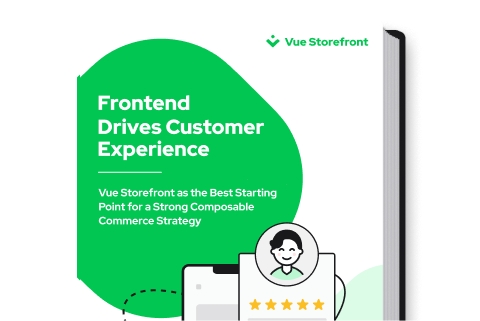Explore by Category:
Frontend
Choosing the right frontend framework is crucial for businesses and developers, but the vast selection available can make the decision difficult. Vendor lock-in can also be a costly issue, limiting flexibility and creating financial burdens. This article highlights the importance of avoiding vendor lock-in and offers guidance on selecting the appropriate frontend technology for your project.
What does vendor lock-in mean?
Vendor lock-in refers to the situation where a customer becomes dependent on a particular vendor's products or services. This can lead to various challenges and drawbacks for the customer who may wish to switch to a different vendor or technology, including but not limited to higher expenses, potential loss of data or features, and a significant amount of time and effort required to make the transition. Such a situation may hinder the ability of the customer to make changes or adapt to evolving needs, which can have a negative impact on their overall business operations.
A no vendor lock-in approach means that a customer or user is not tied to a particular vendor or technology and is free to choose alternatives without being penalized or encountering significant obstacles.
In the context of web development, having no vendor lock-in means that the frontend technology or framework used to build a web application is not proprietary or exclusive to a particular vendor or service provider. This allows developers to use open-source technologies and frameworks which are not owned by any single vendor and are often community-driven.
What are the risks of frontend vendor lock-in?
If a frontend is vendor locked-in, it means that the technology or framework used to build it is owned and controlled by a single vendor, and it may be difficult or expensive to switch to another technology or framework without significant effort or cost. This can create several potential issues for businesses or developers, such as:
Limited flexibility: A vendor-locked frontend may restrict the ability of developers to customize and modify the frontend to suit their specific needs. This can result in limitations on functionality, performance, and scalability.
Limited innovation: Vendor-locked frontends may be slower to adopt new features or technologies that are not part of the vendor's offering. This can limit innovation and make it harder to keep up with the latest trends and best practices.
Risk of obsolescence: If a vendor-locked frontend falls out of favor or becomes obsolete, a business may face significant costs and difficulties in migrating to a new technology or framework.
High costs: If a business is locked into a particular vendor's technology, it may be subject to that vendor's pricing, licensing, and support policies, which can be expensive and inflexible. This can make it difficult to optimize costs or respond to changes in market conditions.
Overall, having a frontend that is vendor locked-in can limit a business's flexibility, innovation, and ability to respond to changing market conditions. It may also result in higher costs and the risk of being locked into a technology that becomes obsolete over time. To avoid these issues, it is generally recommended to use open-source technologies and frameworks that are not tied to a specific vendor.
Benefits of frontend with no vendor lock-in
Having a frontend with no vendor lock-in can provide several benefits for web developers and businesses, including:
Flexibility: A frontend with no vendor lock-in allows developers to choose the best technology and tools for their project. This gives them more flexibility to use the tools and frameworks that work best for their specific needs, rather than being limited to a specific vendor's offerings.
Reduced risk: Vendor lock-in can create risks for businesses, as they may become dependent on a particular vendor and vulnerable to changes in that vendor's pricing, licensing, or support policies. By avoiding vendor lock-in, businesses can reduce this risk and maintain greater control over their technology choices.
Innovation: Having a frontend with no vendor lock-in can foster innovation, as it allows developers to experiment with new tools and frameworks and to stay up to date with the latest developments in web development. This can lead to more cutting-edge and effective solutions for businesses and users alike.
Cost savings: By avoiding vendor lock-in, businesses can avoid being tied to a particular vendor's pricing structure and can instead choose the most cost-effective solutions for their needs. This can lead to significant cost savings in the long run.
Overall, avoiding vendor lock-in can provide businesses with greater flexibility, cost savings, reduced risk, and the ability to innovate more effectively.
Vendor locked-in frontend creates headless monoliths, not a true composable eCommerce stack
Composable commerce empowers businesses to build custom eCommerce architecture by integrating various microservices and applications.
Vendor lock-in is avoided to promote flexibility and enable businesses to choose services from different vendors without limitations. This approach helps businesses to create eCommerce solutions tailored to their unique needs and responsive to changes in the market and customer demands.
No vendor lock-in is crucial for composable commerce as it allows businesses to switch between services, add or remove functionality, and avoid being tied to a vendor's pricing or licensing policies. For example, a business can use a CMS of choice, a payment gateway, a shipping and logistics provider from different vendors to form a cohesive, flexible and futureproof eCommerce system.
Wrap-up
By avoiding vendor lock-in in web development, businesses can gain more flexibility and control over their technology choices, reduce their costs, and avoid being locked into a particular vendor's pricing, licensing, or support policies. This is particularly crucial in the world of MACH architecture , which promotes a flexible mix and match approach ensuring that MACH-driven stores remain futureproof and vendor independent.
Download the ebook to learn more about how to choose the best frontend solution for your eCommerce.
Share:
Share:
More in Frontend
Ready to dive in? Schedule a demo
Get a live, personalised demo with one of our awesome product specialists.






















